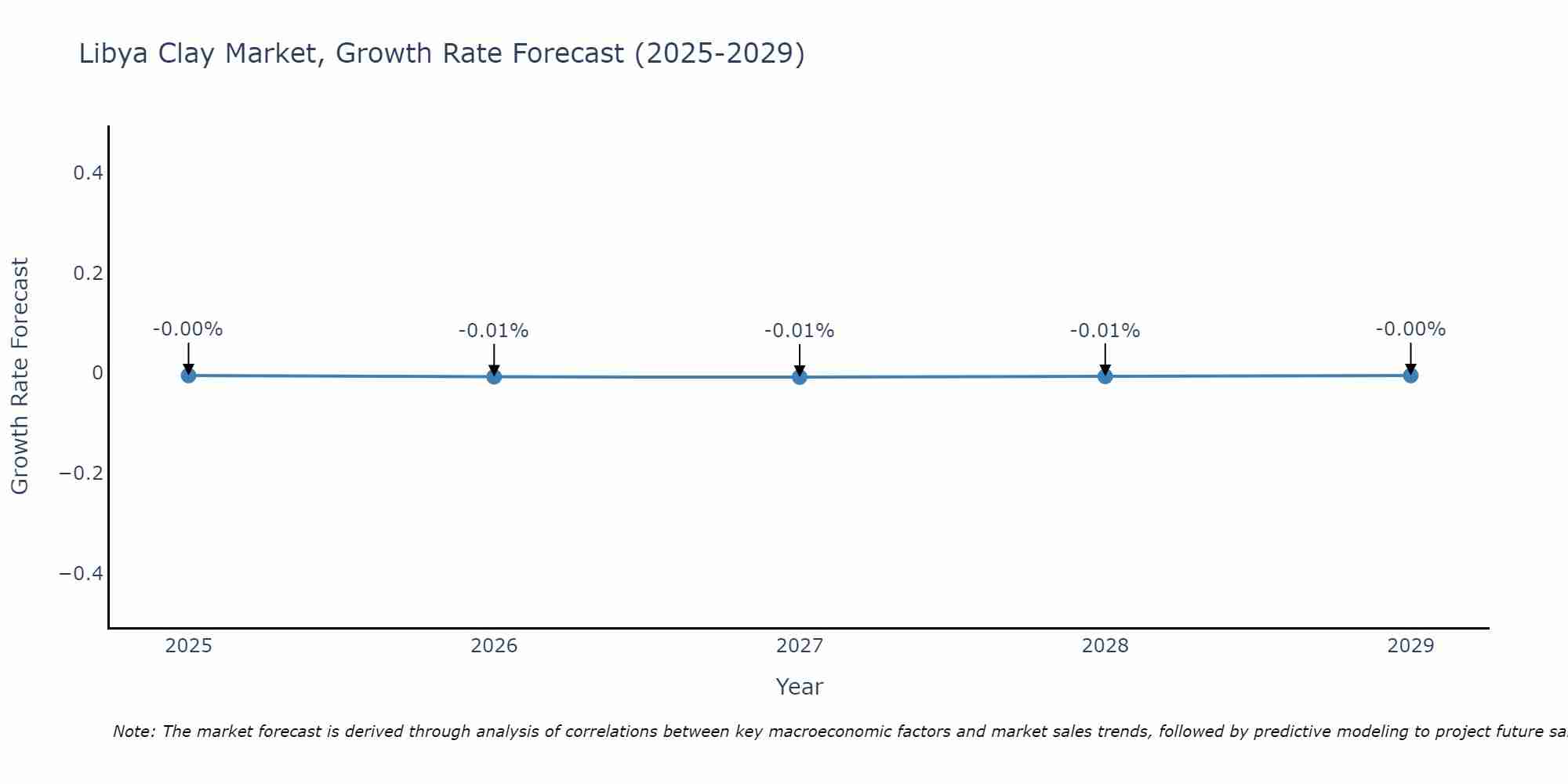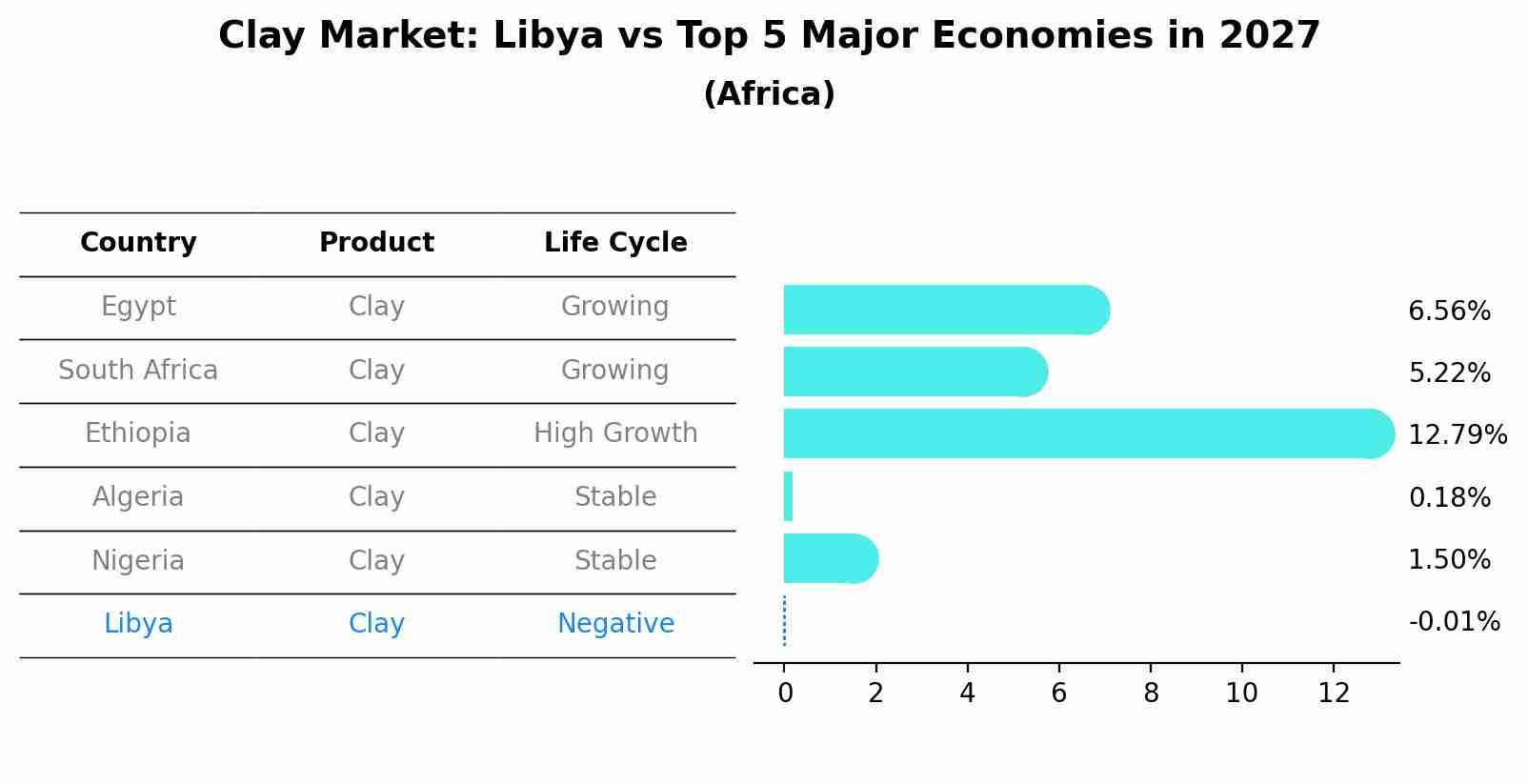Libya Clay Market (2025-2031) | Share, Companies, Size, Trends, Outlook, Growth, Analysis, Industry, Forecast, Segmentation, Value & Revenue
| Product Code: ETC5257680 | Publication Date: Nov 2023 | Updated Date: Sep 2025 | Product Type: Market Research Report | |
| Publisher: 6Wresearch | No. of Pages: 60 | No. of Figures: 30 | No. of Tables: 5 | |
Libya Clay Market Size Growth Rate
The Libya Clay Market is projected to witness mixed growth rate patterns during 2025 to 2029. The growth rate starts at -0.00% in 2025 and reaches -0.00% by 2029.

Clay Market: Libya vs Top 5 Major Economies in 2027 (Africa)
In the Africa region, the Clay market in Libya is projected to expand at a negative growth rate of -0.01% by 2027. The largest economy is Egypt, followed by South Africa, Ethiopia, Algeria and Nigeria.

Key Highlights of the Report:
- Libya Clay Market Outlook
- Market Size of Libya Clay Market, 2024
- Forecast of Libya Clay Market, 2031
- Historical Data and Forecast of Libya Clay Revenues & Volume for the Period 2021-2031
- Libya Clay Market Trend Evolution
- Libya Clay Market Drivers and Challenges
- Libya Clay Price Trends
- Libya Clay Porter`s Five Forces
- Libya Clay Industry Life Cycle
- Historical Data and Forecast of Libya Clay Market Revenues & Volume By Application for the Period 2021-2031
- Historical Data and Forecast of Libya Clay Market Revenues & Volume By Tableware for the Period 2021-2031
- Historical Data and Forecast of Libya Clay Market Revenues & Volume By Sanitary ware for the Period 2021-2031
- Historical Data and Forecast of Libya Clay Market Revenues & Volume By Medical applications for the Period 2021-2031
- Historical Data and Forecast of Libya Clay Market Revenues & Volume By End Use for the Period 2021-2031
- Historical Data and Forecast of Libya Clay Market Revenues & Volume By Ceramic and for the Period 2021-2031
- Historical Data and Forecast of Libya Clay Market Revenues & Volume By Non-ceramic for the Period 2021-2031
- Libya Clay Import Export Trade Statistics
- Market Opportunity Assessment By Application
- Market Opportunity Assessment By End Use
- Libya Clay Top Companies Market Share
- Libya Clay Competitive Benchmarking By Technical and Operational Parameters
- Libya Clay Company Profiles
- Libya Clay Key Strategic Recommendations
Frequently Asked Questions About the Market Study (FAQs):
1 Executive Summary |
2 Introduction |
2.1 Key Highlights of the Report |
2.2 Report Description |
2.3 Market Scope & Segmentation |
2.4 Research Methodology |
2.5 Assumptions |
3 Libya Clay Market Overview |
3.1 Libya Country Macro Economic Indicators |
3.2 Libya Clay Market Revenues & Volume, 2021 & 2031F |
3.3 Libya Clay Market - Industry Life Cycle |
3.4 Libya Clay Market - Porter's Five Forces |
3.5 Libya Clay Market Revenues & Volume Share, By Application, 2021 & 2031F |
3.6 Libya Clay Market Revenues & Volume Share, By End Use, 2021 & 2031F |
4 Libya Clay Market Dynamics |
4.1 Impact Analysis |
4.2 Market Drivers |
4.2.1 Growing construction industry in Libya, leading to increased demand for clay for building materials. |
4.2.2 Increasing focus on sustainable and eco-friendly construction practices, driving demand for clay-based products. |
4.2.3 Government initiatives to promote local manufacturing and reduce import dependency on construction materials. |
4.3 Market Restraints |
4.3.1 Political instability and security concerns in Libya impacting overall business operations and market growth. |
4.3.2 Fluctuating raw material prices affecting production costs and profitability for clay manufacturers. |
4.3.3 Limited technological advancements and infrastructure in the clay industry hindering efficiency and competitiveness. |
5 Libya Clay Market Trends |
6 Libya Clay Market Segmentations |
6.1 Libya Clay Market, By Application |
6.1.1 Overview and Analysis |
6.1.2 Libya Clay Market Revenues & Volume, By Tableware, 2021-2031F |
6.1.3 Libya Clay Market Revenues & Volume, By Sanitary ware, 2021-2031F |
6.1.4 Libya Clay Market Revenues & Volume, By Medical applications, 2021-2031F |
6.2 Libya Clay Market, By End Use |
6.2.1 Overview and Analysis |
6.2.2 Libya Clay Market Revenues & Volume, By Ceramic and, 2021-2031F |
6.2.3 Libya Clay Market Revenues & Volume, By Non-ceramic, 2021-2031F |
7 Libya Clay Market Import-Export Trade Statistics |
7.1 Libya Clay Market Export to Major Countries |
7.2 Libya Clay Market Imports from Major Countries |
8 Libya Clay Market Key Performance Indicators |
8.1 Average clay extraction and processing costs per unit. |
8.2 Number of new construction projects utilizing clay-based materials. |
8.3 Percentage of market share held by local clay manufacturers compared to imports. |
9 Libya Clay Market - Opportunity Assessment |
9.1 Libya Clay Market Opportunity Assessment, By Application, 2021 & 2031F |
9.2 Libya Clay Market Opportunity Assessment, By End Use, 2021 & 2031F |
10 Libya Clay Market - Competitive Landscape |
10.1 Libya Clay Market Revenue Share, By Companies, 2024 |
10.2 Libya Clay Market Competitive Benchmarking, By Operating and Technical Parameters |
11 Company Profiles |
12 Recommendations | 13 Disclaimer |
- Single User License$ 1,995
- Department License$ 2,400
- Site License$ 3,120
- Global License$ 3,795
Search
Related Reports
- ASEAN Bearings Market (2025-2031) | Strategy, Consumer Insights, Analysis, Investment Trends, Opportunities, Growth, Size, Share, Industry, Revenue, Segments, Value, Segmentation, Supply, Forecast, Restraints, Outlook, Competition, Drivers, Trends, Demand, Pricing Analysis, Competitive, Strategic Insights, Companies, Challenges
- Europe Flooring Market (2025-2031) | Outlook, Share, Industry, Trends, Forecast, Companies, Revenue, Size, Analysis, Growth & Value
- Saudi Arabia Manlift Market (2025-2031) | Outlook, Size, Growth, Trends, Companies, Industry, Revenue, Value, Share, Forecast & Analysis
- Uganda Excavator, Crane, and Wheel Loaders Market (2025-2031) | Strategy, Consumer Insights, Analysis, Investment Trends, Opportunities, Growth, Size, Share, Industry, Revenue, Segments, Value, Segmentation, Supply, Forecast, Restraints, Outlook, Competition, Drivers, Trends, Demand, Pricing Analysis, Competitive, Strategic Insights, Companies, Challenges
- Rwanda Excavator, Crane, and Wheel Loaders Market (2025-2031) | Strategy, Consumer Insights, Analysis, Investment Trends, Opportunities, Growth, Size, Share, Industry, Revenue, Segments, Value, Segmentation, Supply, Forecast, Restraints, Outlook, Competition, Drivers, Trends, Demand, Pricing Analysis, Competitive, Strategic Insights, Companies, Challenges
- Kenya Excavator, Crane, and Wheel Loaders Market (2025-2031) | Strategy, Consumer Insights, Analysis, Investment Trends, Opportunities, Growth, Size, Share, Industry, Revenue, Segments, Value, Segmentation, Supply, Forecast, Restraints, Outlook, Competition, Drivers, Trends, Demand, Pricing Analysis, Competitive, Strategic Insights, Companies, Challenges
- Angola Excavator, Crane, and Wheel Loaders Market (2025-2031) | Strategy, Consumer Insights, Analysis, Investment Trends, Opportunities, Growth, Size, Share, Industry, Revenue, Segments, Value, Segmentation, Supply, Forecast, Restraints, Outlook, Competition, Drivers, Trends, Demand, Pricing Analysis, Competitive, Strategic Insights, Companies, Challenges
- Israel Intelligent Transport System Market (2025-2031) | Strategy, Consumer Insights, Analysis, Investment Trends, Opportunities, Growth, Size, Share, Industry, Revenue, Segments, Value, Segmentation, Supply, Forecast, Restraints, Outlook, Competition, Drivers, Trends, Demand, Pricing Analysis, Competitive, Strategic Insights, Companies, Challenges
- Uganda Precast and Aggregate Market (2025-2031) | Strategy, Consumer Insights, Analysis, Investment Trends, Opportunities, Growth, Size, Share, Industry, Revenue, Segments, Value, Segmentation, Supply, Forecast, Restraints, Outlook, Competition, Drivers, Trends, Demand, Pricing Analysis, Competitive, Strategic Insights, Companies, Challenges
- Australia IT Asset Disposal Market (2025-2031) | Strategy, Consumer Insights, Analysis, Investment Trends, Opportunities, Growth, Size, Share, Industry, Revenue, Segments, Value, Segmentation, Supply, Forecast, Restraints, Outlook, Competition, Drivers, Trends, Demand, Pricing Analysis, Competitive, Strategic Insights, Companies, Challenges
Industry Events and Analyst Meet
Our Clients
Whitepaper
- Middle East & Africa Commercial Security Market Click here to view more.
- Middle East & Africa Fire Safety Systems & Equipment Market Click here to view more.
- GCC Drone Market Click here to view more.
- Middle East Lighting Fixture Market Click here to view more.
- GCC Physical & Perimeter Security Market Click here to view more.
6WResearch In News
- Doha a strategic location for EV manufacturing hub: IPA Qatar
- Demand for luxury TVs surging in the GCC, says Samsung
- Empowering Growth: The Thriving Journey of Bangladesh’s Cable Industry
- Demand for luxury TVs surging in the GCC, says Samsung
- Video call with a traditional healer? Once unthinkable, it’s now common in South Africa
- Intelligent Buildings To Smooth GCC’s Path To Net Zero













